Acid buffering - Study guides, Class notes & Summaries
Looking for the best study guides, study notes and summaries about Acid buffering? On this page you'll find 918 study documents about Acid buffering.
Page 2 out of 918 results
Sort by
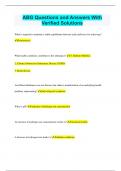
-
ABG Questions and Answers With Verified Solutions
- Exam (elaborations) • 31 pages • 2024
-
Available in package deal
-
- $10.49
- + learn more
ABG Questions and Answers With Verified Solutions What is required to maintain a stable equilibrium between acids and bases for achieving? homeostasis What health conditions contribute to this imbalance? 1. Diabetes Mellitus 2. Chronic Obstructive Pulmonary Disease (COPD) 3. Renal disease Acid-Base Imbalances are not diseases but rather a manifestation of an underlying health problem, representing? physiological symptoms What is pH? indicator of hydrogen ion concentration ...
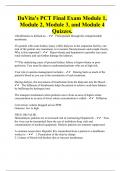 Popular
Popular
-
DaVita's PCT Final Exam Module 1, Module 2, Module 3, and Module 4 Quizzes.
- Exam (elaborations) • 10 pages • 2023 Popular
-
Available in package deal
-
- $12.49
- 1x sold
- + learn more
Ultrafiltration is defined as: - Fluid pushed through the semipermeable membrane If a patient with acute kidney injury (AKI) dialyzes in the outpatient facility, one task of the patient care teammates is to monitor blood pressure and weight closely. Why is this important? - Hypovolemia and hypotensive episodes can cause renal ischemia and can further damage the kidneys. ***The underlying cause of prerenal kidney failure is hypovolemia or poor perfusion. Care must be taken to understa...

-
WGU D236 pathophysiology Exam -Study Guide-With 100% verified answers-2022-2023
- Exam (elaborations) • 26 pages • 2022
-
- $9.79
- 4x sold
- + learn more
1. What is Starling's Law of Capillary forces? How does this explain why a nutritionally deficient child would have edema? Starling’s Law describes how fluids move across the capillary membrane. There are two major opposing forces that act to balance each other, hydrostatic pressure (pushing water out of the capillaries) and osmotic pressure (including oncontic pressure, which pushes fluid into the capillaries). Both electrolytes and proteins (oncontic pressure) in the blood affect osmot...

-
WGU pathophysiology D236 Questions With Complete Solutions
- Exam (elaborations) • 31 pages • 2022
-
Available in package deal
-
- $12.49
- 1x sold
- + learn more
What is Starling's Law of Capillary forces? How does this explain why a nutritionally deficient child would have edema? Correct Answer: Starling's Law describes how fluids move across the capillary membrane. There are two major opposing forces that act to balance each other, hydrostatic pressure (pushing water out of the capillaries) and osmotic pressure (including oncontic pressure, which pushes fluid into the capillaries). Both electrolytes and proteins (oncontic pressure) in the bl...
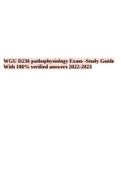
-
WGU D236 pathophysiology OA Exam -Study Guide With 100% verified answers 2022-2023.
- Exam (elaborations) • 28 pages • 2023
- Available in package deal
-
- $10.99
- 1x sold
- + learn more
WGU D236 pathophysiology OA Exam -Study Guide With 100% verified answers 2022-2023. Patho OA Study Guide 1. What is Starling's Law of Capillary forces? How does this explain why a nutritionally deficient child would have edema? Starling’s Law describes how fluids move across the capillary membrane. There are two major opposing forces that act to balance each other, hydrostatic pressure (pushing water out of the capillaries) and osmotic pressure (including oncontic pressure, which p...

-
BCH 361 IClicker Questions Study Questions with 100% Correct Verified Solutions| Latest Update
- Exam (elaborations) • 29 pages • 2024
- Available in package deal
-
- $12.99
- + learn more
The titration curve of phosphoric acid is shown on the right. Which pH is not within the buffering range of phosphoric acid and its conjugate bases? A. 2.0 B. 4.0 C. 7.2 D. 12.4 - Answer B. 4.0
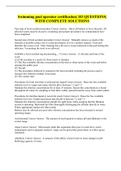
-
Swimming pool operator certification| 103 QUESTIONS| WITH COMPLETE SOLUTIONS
- Exam (elaborations) • 9 pages • 2022
-
Available in package deal
-
- $12.49
- 1x sold
- + learn more
First step of fecal accident procedure Correct Answer: Direct all bathers to leave the pool. All affected waters must be closed to swimming until proper procedures for contamination have been completed Second step of fecal accident procedure Correct Answer: Manually remove as much of the material as possible using a net or scoop and dispose of it in a sanitary manner. Clean and disinfect the scoop or net. After cleaning leave the net or scoop immersed in the pool during this infection. Vacu...
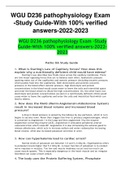
-
1. What is Starling's Law of Capillary forces? How does this explain why a nutritionally deficient child would have edema? Starling’s Law describes how fluids move across the capillary membrane. There are two major opposing forces that act to balance e
- Summary • 28 pages • 2023
-
Available in package deal
-
- $15.49
- 1x sold
- + learn more
1. What is Starling's Law of Capillary forces? How does this explain why a nutritionally deficient child would have edema? Starling’s Law describes how fluids move across the capillary membrane. There are two major opposing forces that act to balance each other, hydrostatic pressure (pushing water out of the capillaries) and osmotic pressure (including oncontic pressure, which pushes fluid into the capillaries). Both electrolytes and proteins (oncontic pressure) in the blood affect osmo...
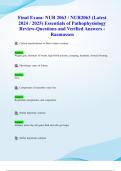
-
Final Exam: NUR 2063 / NUR2063 (Latest 2024 / 2025) Essentials of Pathophysiology Review-Questions and Verified Answers - Rasmussen
- Exam (elaborations) • 52 pages • 2024
-
Available in package deal
-
- $11.49
- + learn more
Final Exam: NUR 2063 / NUR2063 (Latest 2024 / 2025) Essentials of Pathophysiology Review-Questions and Verified Answers - Rasmussen Q: Clinical manifestations of fluid volume overload Answer: Weight gain, shortness of breath, high blood pressure, cramping, headache, stomach bloating Q: Physiologic cause of Edema Answer: N/A Q: Components of insensible water loss Answer: Respiration, perspiration, and evaporation Q: Define hypotonic solution Answer: So...
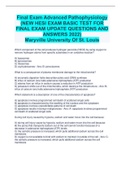
-
Final Exam Advanced Pathophysiology (NEW HESI EXAM BASIC TEST FOR FINAL EXAM UPDATE QUESTIONS AND ANSWERS 2022) Maryville University Of St. Louis
- Exam (elaborations) • 10 pages • 2022
-
- $9.49
- 2x sold
- + learn more
Final Exam Advanced Pathophysiology (NEW HESI EXAM BASIC TEST FOR FINAL EXAM UPDATE QUESTIONS AND ANSWERS 2022) Maryville University Of St. Louis Which component of the cell produces hydrogen peroxide (H2O2) by using oxygen to remove hydrogen atoms from specific substrates in an oxidative reaction? A) lysosomes B) peroxisomes C) ribosomes D) oxyhydrosomes - Ans: B- peroxisomes What is a consequence of plasma membrane damage to the mitochondria? A) enzymatic digestion halts deo...

Do you wonder why so many students wear nice clothes, have money to spare and enjoy tons of free time? Well, they sell on Stuvia! Imagine your study notes being downloaded a dozen times for $15 each. Every. Single. Day. Discover all about earning on Stuvia


